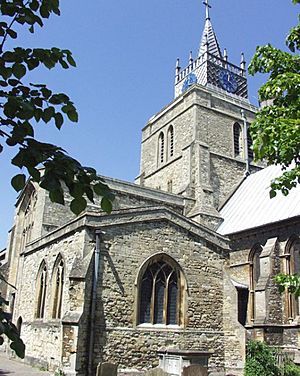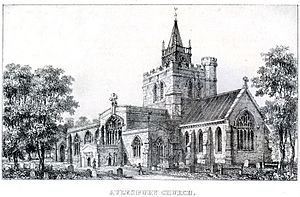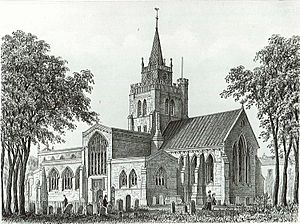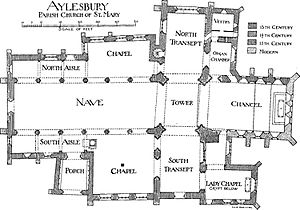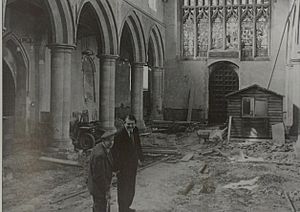St Mary the Virgin's Church, Aylesbury facts for kids
Quick facts for kids St Mary's |
|
|---|---|
| Church of St Mary the Virgin | |
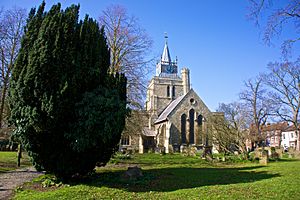 |
|
| 51°49′05″N 0°48′58″W / 51.817950°N 0.816050°W | |
| Location | Aylesbury |
| Country | England |
| Denomination | Church of England |
| Tradition | Broad Church |
| History | |
| Consecrated | 1200-1250 |
| Specifications | |
| Capacity | (currently) 150 approx |
| Length | 140ft |
| Nave length | 78ft |
| Choir length | 41ft |
| Width | 66ft |
| Nave width | 26ft |
| Width across transepts | 20ft |
| Height | 121ft |
| Nave height | 70ft |
| Number of towers | 1 |
| Tower height | 21ft |
| Number of spires | 1 |
| Spire height | 22ft |
| Administration | |
| Archdeaconry | Buckingham |
| Diocese | Oxford (since 1541) |
| Province | Canterbury |
The Church of St Mary the Virgin, Aylesbury is an Anglican church in the heart of Aylesbury, England. It belongs to the Diocese of Oxford. While there's proof of a church here since Saxon times, the building you see today was mostly built between 1200 and 1250. Over the centuries, many parts were added or changed, especially in the 14th, 15th, 19th, and 20th centuries.
This church is one of Aylesbury's most famous landmarks. Its beautiful clock tower stands out in the town's skyline. St Mary's Church is currently a Grade I listed building, which means it's a very important historical building.
A Look Back in Time
Saxon Beginnings
Aylesbury had a church even in Saxon times. During repairs in the 1800s, workers found parts of an old underground room called a crypt. Stone steps led down from the church into this crypt. Experts believe a large arch found there is from the Saxon period. This crypt might be what's left of a Saxon church, possibly from around 571 AD, when Aylesbury was a Saxon settlement known as Aeglesburge.
This hidden room might have been used for worship during difficult times. Later, it seems to have been a charnel house, a place where human bones were stored. Many bones were found there, which were later moved and reburied in the churchyard.
It's possible this was the burial site of St. Osyth in the 9th century. Her burial place in Aylesbury became a popular spot for visitors, even though it wasn't officially allowed. After a special order from the Pope in 1500, her bones were secretly removed and buried elsewhere.
Norman Font and Early Church Life
We know there was an older church before the current one because of a beautiful Norman font found inside. This font and other old items were discovered buried under the church during 19th-century renovations. The font was found in three pieces and carefully put back together. You can see it at the west end of the church today. This font is so special that it gave its name to a style of fonts called "Aylesbury Fonts," usually made between 1170 and 1190.
The early history of the church in Aylesbury is a bit complicated. The church was connected to Lincoln Cathedral as a "prebend," which meant it provided income for a special position there. Records show this link existed as early as 1092.
During recent digging work, parts of a 12th-century cloister (a covered walkway) and a water pipe were also found.
Building the Church (1200s)
The church we see today was likely built between 1200 and 1250, with changes made during the reigns of King John or Henry III of England. Originally, the church had a cruciform (cross-shaped) design, with a chancel (the area around the altar), a nave (the main part where people sit), transepts (the arms of the cross), and a tower. It still mostly looks like that, even with all the changes over time.
From the 11th to 14th centuries, many cathedrals and smaller churches were built across Europe. Aylesbury's church was part of this trend. Besides being a place of worship, churches back then were used for many community activities. They could be meeting places for groups, halls for parties, or even stages for plays. Sometimes, they were even used to store grain.
Changes in the 1300s and 1400s
One of the most interesting parts of the church is the Lady Chapel, a beautiful addition from the 14th century. In this chapel, old stone seats called a sedilia were found built into the wall.
It's thought that the original church building only went as far as the nave and had a high, pointed roof. To get more light, a clerestory (a row of windows high up) and a flat roof were probably added in the 15th century. The east ends of the north and south chapels were also likely made larger around this time. These are now known as the Chapel of St George and the Chapter House.
In 1450, a religious group called the Guild of St Mary was started in Aylesbury. It was a popular meeting place for important local people and was involved in politics, even influencing the Wars of the Roses. The guild's old building is still there today, though it's now almshouses (housing for poor people). The church's priest likely performed special services for the guild in the chapel.
A record from 1494 shows that John Stone of Aylesbury left two properties to the church. The money from these properties was meant to pay for the upkeep of a clock and chimes in the church tower forever.
The tower's main supports started to weaken early on. Over time, different ways were tried to make them stronger. An arch between the south-east support and the transept was so damaged by the 15th century that it had to be blocked up. The tower's southern and eastern arches also seemed damaged. Around the same time, the arch on the west side of the transept was walled up.
During this period, the Lady Chapel and sacristy (now called the vestry) were probably built. The sacristy looks like the oldest part of the building today. Inside, there's a 15th-century oak wardrobe with a clever swinging rack for hanging the priest's robes. There's also a strong locker where sacred items were likely kept. Above the sacristy is a room called the priest's chamber, or priest's hole. The walls in this part of the building are very thick, and the door is a strong and unusual one from the 15th century.
The Church in the 1500s and 1600s
Later, in 1596 and 1599, more stonework was added to strengthen the tower supports.
In 1534, the church became part of the newly formed Church of England, separating from the Roman Catholic Church. This happened under King Henry VIII. He also made Aylesbury the official county town instead of Buckingham, which helped the church grow.
Under King Edward VI, more Protestant ways of worship were adopted. A new prayer book, the Book of Common Prayer, was introduced in 1549 and 1552.
After Henry VIII and Edward VI, Mary Tudor became queen. She tried to bring back the Catholic faith. However, many church paintings were already lost when church interiors were whitewashed.
In the north transept, there's a beautiful monument to Lady Lee, wife of Sir Henry Lee, who was a personal champion to Queen Elizabeth I. Lady Lee died in 1584.
Aylesbury Grammar School was founded in 1598 and first met inside the church. The school ran from 9 am to 2 pm. The Vicar of Aylesbury was one of the school's trustees.
In 1611, Aylesbury Grammar School moved to what were then church buildings. These buildings now house the County Museum. The school stayed there until 1907.
More repairs were needed in the 1600s as the tower supports continued to have problems. This shows that even the earlier repairs didn't always last.
There are no monuments from the 17th century or earlier in Aylesbury Church, and it didn't have any old stained glass when it was restored later. This suggests the church went through some very rough times. During 19th-century restoration, damage was found on the stone work that couldn't have been accidental. This damage is thought to have happened during the English Civil War in the time of King Charles I. Aylesbury was heavily affected by the war, and it would have been unusual if the church had escaped damage. For example, in 1642, a soldier wrote about how his men "got into the church, defaced the ancient and sacred glazed pictures, and burned the holy rails."
The church used to have an old gallery with a special "bird-cage pew." This pew was enclosed with lattice work and looked like a private box at an opera. It was the old manor pew and was used by judges and the high sheriff during important events. The church also had a tall pulpit nicknamed a 'three-decker'.
Some pews in the church had brass rails and curtains to make them more private. In the north chapel, there were high pews that were several steps above the floor. The main part of the church was filled with panelled pews, and people felt they owned their specific pew. These pews were all different shapes and sizes, and many owners kept them locked.
In 1642, a minister named Rev John Barton was accused of speaking against the Parliament. He was briefly held in custody and later removed from the vicarage.
In 1691, a clockmaker named John Aylward was given the properties left by John Stone in 1494. In return, he had to build and maintain a strong clock and chimes in the church tower for 31 years. This property was known as the Clock and Chimes Estate.
The church tower is topped by a small spire, which is believed to be from the time of Charles II.
The 1700s: Repairs and Changes
The unique pews were still in the church in the 1700s. In 1759, a man named 'Dear Dell' asked John Wilkes if he could use his empty family pew, but Wilkes refused.
In 1756, it was suggested that a gallery should be built in the church. It was also decided that the "middle aisle" of the church should have a ceiling.
Also in 1756, a record in the Aylesbury churchwardens (church officials) book mentions a charge "for setting the yew tree in the Churchyard." Yew trees were sometimes planted in churchyards to provide wood for bows for archers, or to protect the church from storms.
By 1765, the church building was in bad shape. A surveyor named Mr. Keen reported that it was very unsafe and needed to be rebuilt. The parishioners tried to raise money for repairs, but it wasn't very popular.
Before a major restoration in the 1800s, only a small part of the church was used for services. The south transept, for example, was used to store equipment for the parish fire brigade.
Major Renovations in the 1800s
During the Napoleonic Wars, gunpowder for local soldiers was stored deep inside the church.
In 1821, the churchwardens spent £250 to build a stable, coach house, and washhouse, which the Charity Commissioners were not happy about.
Big renovation projects began after a report in the 1830s. Before the restoration, memorial tablets were all over the church, but mostly in the chancel and north transept.
The church had been poorly maintained for many years, leading to a lot of debt from useless repairs. The real restoration work started in 1842. However, the costs were very high, and it was clear that money couldn't be raised just from church taxes or appeals to local people.
A surveyor from London had looked at the church many years before 1848. He famously said the church might stand until he reached Watford, but it would fall before he got home. On September 24, 1848, during Sunday morning service, the church chimes broke and made a loud noise in the tower. Many people thought the surveyor's prediction was coming true and that the church was falling down! There was a panic, and people rushed to escape. Some climbed over pews, and others fell over each other. After the more scared people reached the churchyard and realized nothing was wrong, they returned to their seats, and the service continued.
A survey in 1848 by Sir Gilbert Scott showed serious problems with the church's foundations, walls, and roof.
In 1849, a meeting was held to discuss Scott's report. The church officials decided to borrow £3,000 for repairs. This meeting was very heated, with many Nonconformists (Protestants who were not part of the Church of England) strongly opposing the borrowing. However, the plan was approved after a vote by the parish. The new churchwarden, Mr. Z. D. Hunt, promised that the money would be spent only on necessary repairs for religious instruction, not on decorations. The old pews, galleries, and partitions were removed and sold, and contracts were made for repairs and interior restoration. The church was closed, and services were held in the County Hall.
An ecclesiastical census (a count of church attendance) in England on March 30, 1851, showed that on Sunday morning, 700 people attended St Mary's, plus 180 in Sunday school, for a total of 880. On Sunday evening, 800 people attended, plus 180 in Sunday school, for a total of 980.
On Whitsun 1851, the congregation returned to the church, but the restoration was far from finished. There were no permanent seats, so people sat on chairs. The chancel (the area around the altar) had not yet been restored.
In May 1852, another meeting was held to decide how to pay for new seating. It was agreed that money should be raised through donations.
By autumn 1853, the work picked up again. The main delay was caused by a few parishioners arguing about their right to specific seats. The seating wasn't finished until 1854, and the final touches to the nave were still being done. The chancel was finally completed in 1855 at a cost of about £1,000.
After the interior was finished, people started thinking about restoring the outside. This work began in earnest in 1865. A committee was formed, and they decided to rely on donations rather than a church tax. Their appeal for funds was very successful.
By September of that year, £1,558 had been donated. Work began on the west end of the church in spring 1866. As more donations came in, it was decided to do an even more thorough job than planned. Old rough coverings were removed, and a beautiful stone wall was put in their place. The buttresses (supports) were rebuilt on strong foundations. The foundations are now even stronger than when the church was first built.
The outside of the building was extensively repaired and straightened. The completion of the restoration was celebrated with special services on September 28, 1869. The church was beautifully decorated, and the bells rang joyfully. A public lunch was held, and £800 was donated, which helped clear almost all the costs of the restoration, which totaled about £16,000 (around £731,000 today).
The Church in the 1900s and 2000s
In the 1970s, the church was again thought to be very unstable, and at one point, it seemed like it might be torn down.
In January 1976, after storm damage, the decorative top part of the tower was removed.
Money was raised, and the church closed in April 1978 for major restoration work. The inside of the building was almost completely emptied so that a big project could begin. The plan was to spend over £250,000 to make it a dual-purpose building for both religious and community activities. The work was finished within a year, and a new internal layout, floor, lighting, and heating system were installed.
A refectory (a dining hall) was built in the old south porch of the church, and the main entrance was moved to the south transept.
Today, the building needs renovation again. A large amount of money is needed to re-roof the south side of the church because of leaks in the south transept, chapter house, and refectory.
Churchyard History
The churchyard of St Mary’s was much larger in Late Saxon and medieval times. Skeletons have been found in various places nearby, suggesting the churchyard extended further. Records also suggest that St Mary’s was the site of an important Saxon minster (a type of church) and an 11th-century mint (where coins were made) under Edward the Confessor.
Other signs of Saxon and medieval activity, besides burials, have been found in the area, such as ditches, pits, and wells from the 10th to 14th centuries. There's also a theory that Aylesbury might have been a Saxon burh (a fortified town), but there isn't much physical evidence for this.
Tradition says that Aylesbury Churchyard used to be a gathering place for idle and rowdy people in the town. All sorts of sports and games were played there, including "cock-shying" (a game involving throwing things at a rooster). Soldiers were even reported to have been flogged there. While there's no proof now, it's possible these things happened.
Even in the early 1700s, town elections were held in the churchyard. Candidates would stand on an old tomb (which is now gone) to speak to the voters. If there was no competition, the election ended there. But if there was a vote, they would move to the County Hall. The last time nominations were made on this old tomb was in 1802.
While there are no old memorials on the north side of the churchyard, the south side was so full of burials that no more could be added. Since there was no other burial place, the less popular north side had to be used. People who died in difficult circumstances, like those executed or who took their own lives, were sometimes buried "behind Church" without a Christian burial.
Aylesbury Churchyard used to have several public footpaths that are now closed. There was an entrance at the west corner, with paths leading to the west end and south door of the church. There was also a path from Church Row to the church. The churchyard didn't have a proper fence, and it was often used as a playground by the boys from Aylesbury Grammar School and other children in town. So much damage was done that an old parish beadle (a church officer) was appointed to keep order in the burial ground.
The churchyard became very overcrowded as a burial place. It was hard to find space for new burials without disturbing older ones. Because of this, it was closed at the end of 1857. A new cemetery was then opened on Tring Road. Occasionally, burials still take place in the churchyard.
Music and Bells
Music is an important part of St Mary's church and community life, especially during worship and other activities held in the building.
Church Bells
In 1773, a new set of bells was installed. Three old bells were traded for new ones from Pack and Chapman of London. The oldest bell in the tower is the "saints' bell," which dates back to 1612. Today, there are a total of nine bells: the sanctus bell, six from 1773, and two bells from 1850 made by Mears of London.
The Organ
The church's first church organ was a gift from Mrs Mary Pitches in 1782. At a church meeting, £20 a year was set aside for an organist. When Mrs Pitches died in 1800, she left £500 to provide income for the organist.
This organ was built by Green of Lichfield and was improved in 1858. Not much of the original instrument is left today.
The organ has been in different places in the church. First, it was in a gallery above the tower, facing the nave, with the organist and choir in front of it. Then it moved to the center of the west end, near the west door. During the major restoration in the 1800s, it was placed in a special room in the north transept. J. W. Walkers maintained a two-manual organ until the 1978 renovation. This organ was then moved high up into the north transept. Hill Norman and Beard took over maintenance and also installed a smaller pipe organ. The choir also moved to sing from a gallery under the west window. The new organ and rebuild were opened with a concert by Peter Hurford in 1979.
The original organ stopped working several years ago, and an electric organ is now used instead. However, the original organ remains in the church, though it doesn't work.
The Choir
The choir helps lead worship every Sunday during the Parish Eucharist. They also sing at special town services, carol services, and weddings.
Friends of St Mary's
The Friends of St Mary's group organizes classical music concerts at the church, usually about once a month.
See also
- Vicars of the Parish Church of St. Mary the Virgin, Aylesbury
- Prebendaries of Aylesbury



